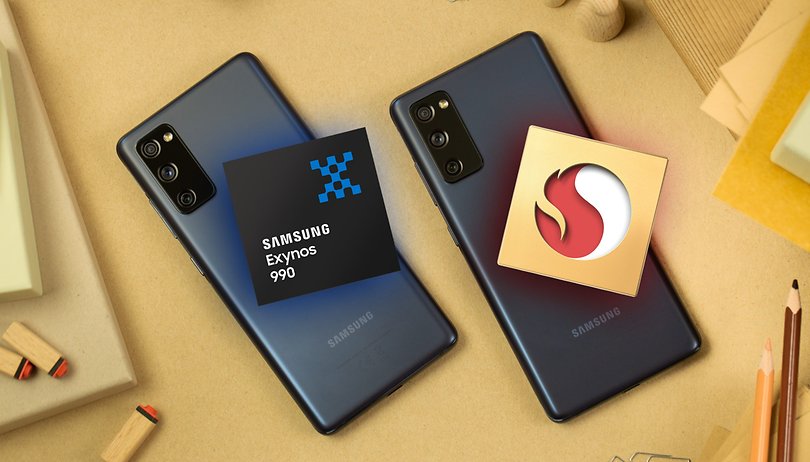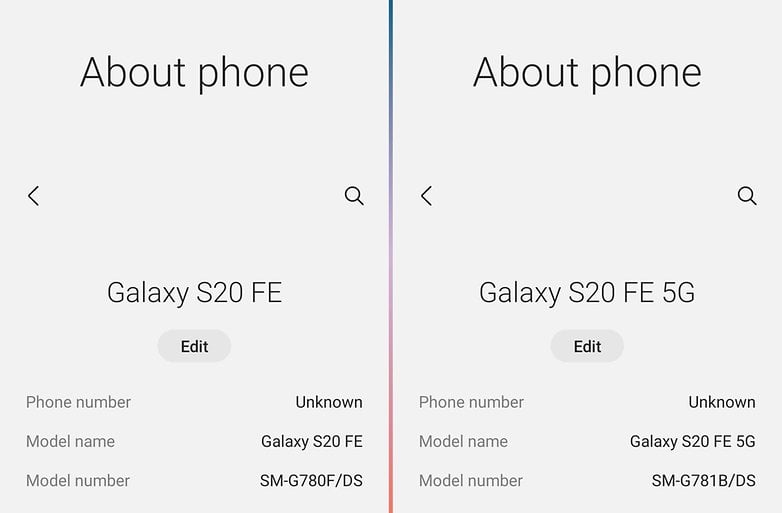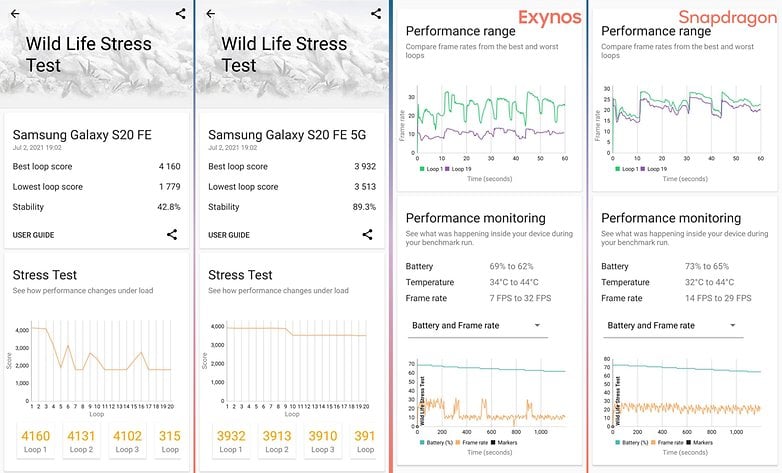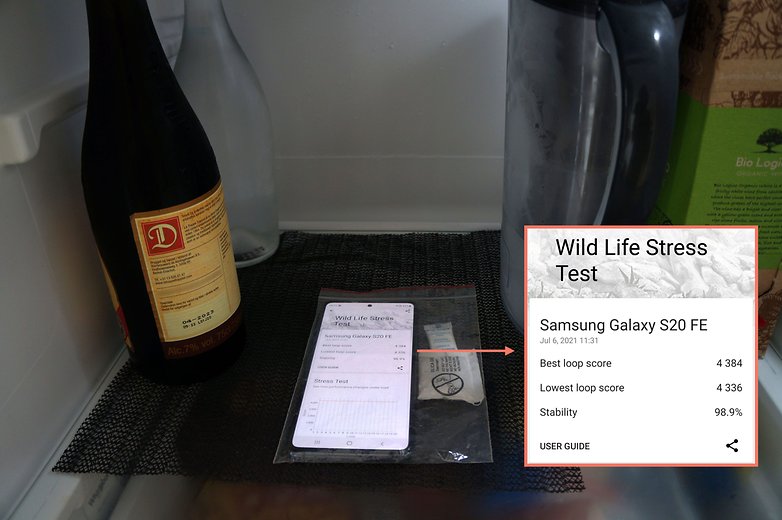Samsung Galaxy S20 FE: Exynos vs Snapdragon?


Exynos versus Snapdragon: for years, consumers in Europe and America live out this dilemma every single year concerning just which SoC will they receive in their Samsung handsets. This question was particularly pertinent in the Galaxy S and Note lines. Armed with the different versions of the Galaxy S20 FE that carried the Exynos 990 and Snapdragon 865 chipsets, we put the two premium processors to the sword by running them against one another in a battery of benchmark tests.
This article is not a traditional comparison like the ones usually normally found here on NextPit. Both models are virtually identical in terms of specifications and components, apart from the SoC used.
Exynos and Snapdragon on the same shelf
The Galaxy S20 FE launched in late 2020 with two versions - a 4G version equipped with the Samsung Exynos 990 processor and a 5G capable model with the Qualcomm Snapdragon 865 regardless of the region it was released in. After all, Samsung Electronics traditionally reserves its Snapdragon-powered phones for the Chinese and North American markets.
Recently, the Exynos 990 version was removed in Europe and Latin America, making way for the Snapdragon 865-equipped model. The new model, while still offering 4G connectivity, can be identified by product code SM-G780G - versus the SM-G780F and SM-G781B identifiers of the original 4G and 5G versions, respectively.
We weren't able to get our hands on the new revision in order to compare it with the old one, but nonetheless, we put the 4G and 5G versions in a head-to-head shootout. It's worth noting that in addition to the processor, the 5G model includes a Snapdragon X55 modem which is the same one used in the iPhone 12 range, but all tests were done without a SIM card in order to isolate the component's impact as much as possible.

Bug fixed and performance improvement
Just so that everyone is aware, prior to performing the benchmarks using the most current firmware version, we ran the benchmarks on the version sent by Samsung straight from the factory in order to try to identify variations in the behavior between the two Galaxy S20 FE handsets.
In the case of the 5G model with Snapdragon, even with the transition between OneUI 2.5 armed with the October 2020 patch and the updated OneUI 3.1 version, there was no significant variation in the results. On the other hand, in the Exynos model (shipped with the Dec/2020 firmware and OneUI 3.0), there was a significant performance improvement, not to mention a bug fix.
In the first run of the 3DMark Wild Life benchmark, the device consistently registered a lower score of around 2,190 points, followed by subsequent scores in the region of 4,200 points. In the case of the Stress Test, the initial score was between 2,115 and 2,136 points and then it hovered between 1,750 and 4,200 points.
After updating the handsets to the latest firmware from June 2021 and resetting it to the factory setting, the 4G model started to behave more consistently as well as improved its performance in some benchmarks.

Performance: Exynos 990 vs Snapdragon 865
| Benchmark | Snapdragon 865 | Exynos 990 |
|---|---|---|
| 3DMark Wild Life | 3.927 | 4.170 (3.599) |
| 3DMark Wild Life Stress Test | 3.513 ~ 3.932 | 1.779 ~ 4.160 (2.115~2.136) |
| Geekbench single-core | 901 | 887 (785) |
| Geekbench multi-core | 3.222 | 2.594 (2.399) |
| PassMark RAM | 25.907 | 24.024 (22.788) |
| PassMark storage | 60.208 | 58.174 (59.310) |
| GFXBench Aztec (Normal, offscreen) | 3.797 | 3.184 |
| () = score with original firmware | ||
In terms of temperature, both models warmed up in a normal way, but the Exynos version was clearly more susceptible to thermal throttling, dropping performance over time in longer benchmarks just to avoid overheating.
In reality, this has the potential to manifest itself during intense gaming sessions, with reduced frame rates in longer gaming sessions. The Wild Life Stress Test benchmark illustrates this point very well (test was conducted without a SIM card inserted and with airplane mode enabled):

The 5G model, meanwhile, achieved far more consistent results with a 89.3% stability rate - versus 42.8% for the Exynos version.
Thermal throttling in practice
To prove that thermal throttling kicked in, we called for an unrealistic test. Unless you live in a place where the sun still shines at midnight, we put the Galaxy S20 FE 4G through a similar test in the fridge. Please do not try this at home!

The result was not only a more stable score that ranged between 4,336 and 4,384 points, which points to a 98.9 percent stability, but it is also superior to the same model at room temperature, which was between 20 and 24 degrees during regular testing.
Of course, the test has no relevance in day-to-day use, but it does show that the Exynos 990 strives to offer performance equivalent to the Snapdragon 865. However, it is unable to sustain such performance levels in the medium term. The observation may not apply to traditional mobile usage that features short periods of heavy use, but it's something to bear in mind during gaming sessions, HD video recording and editing, and other processor-intensive tasks.
Which processor consumes more battery?
Apart from the performance difference, another comment commonly made concerning Exynos processors point to higher power consumption, and consequently, a shorter battery life. In order to test the processors in this matter, we used the PCMark app battery life benchmark, which simulates common tasks in use until it arrives at 20% remaining battery life.
Here, even with a modem installed next to the SoC (which remained disabled throughout the test), the Galaxy S20 FE with Snapdragon 865 showed a greater battery life, with 12h 12min in the test, against 9h 32min the Exynos 990-equipped model.

PCMark Work 3.0
| Scores | Exynos 990 | Snapdragon 865 |
|---|---|---|
| Battery life | 9h32min | 12h12min |
| Overall performance | 12.753 | 12.863 |
| Web browsing | 10.857 | 10.914 |
| Video editing | 6.896 | 7.137 |
| Text edition | 12.531 | 14.035 |
| Image editing | 33.799 | 29.309 |
| Data processing | 10.636 | 10.991 |
In the processor benchmarks run by PCMark, the two SoCs showed similar overall results, reinforcing the perception of equivalent performance for everyday tasks, but at the cost of battery consumption in this case.
Conclusion: Exynos or Snapdragon?
This comparison focused on the performance differences between the models equipped with the Exynos 990 and Snapdragon 865 SoCs in the Galaxy S20 FE. Ideally, we would use the new 4G model with the Snapdragon 865 (SM-G780G), but that wasn't possible for this article.
Apart from the processor and modem, the devices are basically identical in all aspects when taking main daily tasks into consideration. In some situations, however, the loading time of the tests was slightly longer on the Exynos-powered model, reflecting the difference in the PassMark app's storage benchmark score.
What is noticeable when testing the devices side-by-side, is the higher power consumption of the Galaxy S20 FE equipped with the Exynos 990 processor, not to mention a greater variance in its results when it comes to longer and more demanding benchmarks as the speed is throttled due to temperature management in order to avoid the CPU from overheating. This is a trend seen in the Exynos 2100 and Snapdragon 888 flagship processors of 2021, with both of them rolling off Samsung's manufacturing lines.
If you are considering picking up the Galaxy S20 FE 4G, it is worth keeping an eye on the model number, as it is better to pick the SM-G780G model that is powered by the Snapdragon 865 SoC. The main reason for doing so? Better battery life in the long run.
Although the strategy of varied processors for different regions of the world does not show any signs that it will be changed anytime soon, at least the performance difference between the SoCs of 2021 is far less noticeable, as shown in this year's review.
Speaking of reviews, stay tuned to NextPit to read the full Samsung Galaxy S20 FE 5G review. If you're interested to see how the Snapdragon 865 fares in the fridge test, don't forget to leave a comment!
Samsung Galaxy S20 FE 4G vs Galaxy S20 FE 5G
| Samsung Galaxy S20 FE 4G SM-G780F |
Samsung Galaxy S20 FE 5G SM-G781B |
|
|---|---|---|
| Processor | Samsung Exynos 990
|
Qualcomm Snapdragon 865
|
| Memory | 8 / 128 GB (on tested models) | |
| Operating system | Android 11, with OneUI 3.1 (RP1A.200720.012.G780FXXU4CUF1) |
Android 11, with OneUI 3.1 (RP1A.200720.012.G781BXXU3CUE3) |
| Security Patch | June 1, 2021 | |
Check out other articles about the Samsung Galaxy S family on NextPit:



















